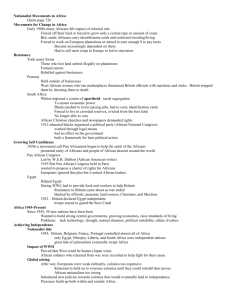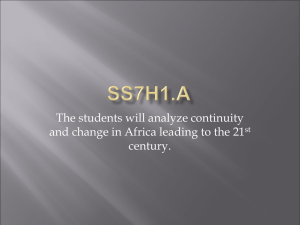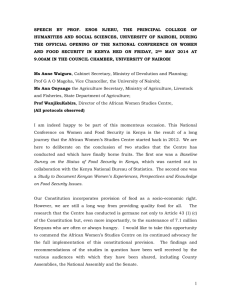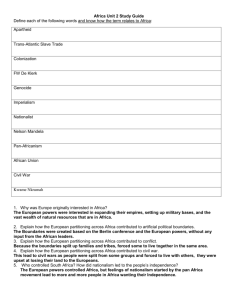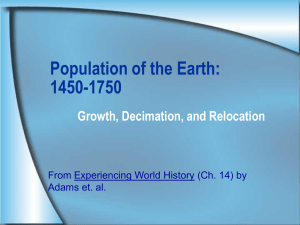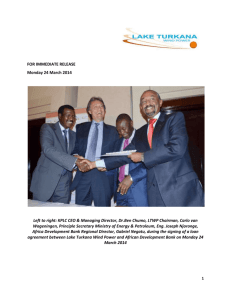political development and the struggle for independence in kenya
advertisement
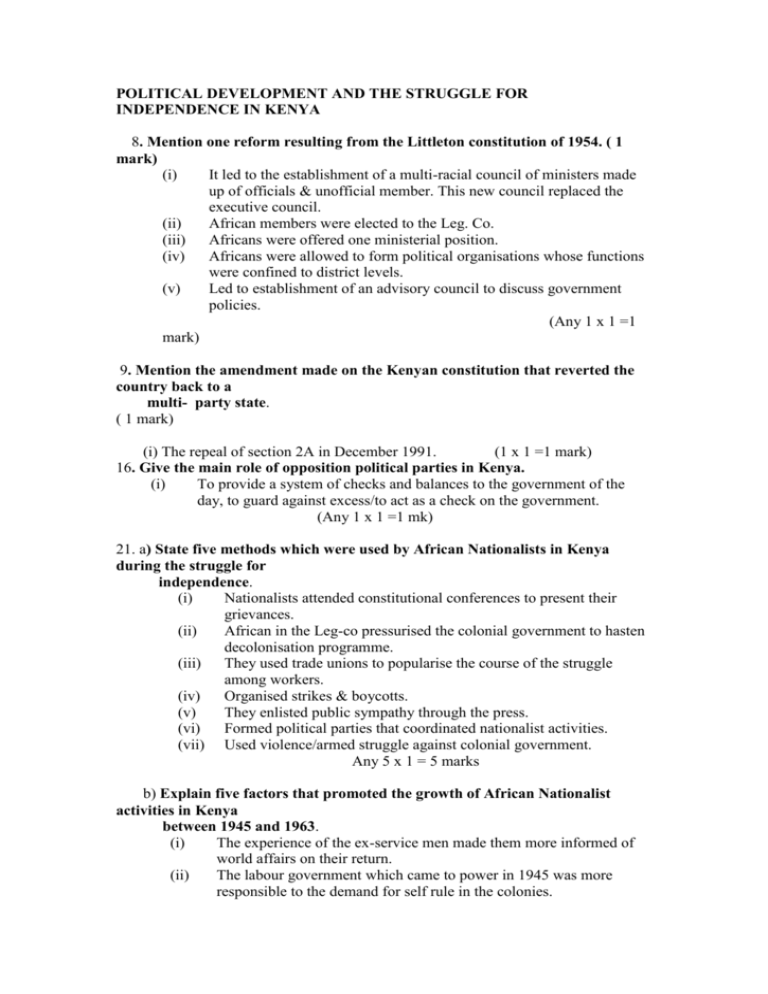
POLITICAL DEVELOPMENT AND THE STRUGGLE FOR INDEPENDENCE IN KENYA 8. Mention one reform resulting from the Littleton constitution of 1954. ( 1 mark) (i) It led to the establishment of a multi-racial council of ministers made up of officials & unofficial member. This new council replaced the executive council. (ii) African members were elected to the Leg. Co. (iii) Africans were offered one ministerial position. (iv) Africans were allowed to form political organisations whose functions were confined to district levels. (v) Led to establishment of an advisory council to discuss government policies. (Any 1 x 1 =1 mark) 9. Mention the amendment made on the Kenyan constitution that reverted the country back to a multi- party state. ( 1 mark) (i) The repeal of section 2A in December 1991. (1 x 1 =1 mark) 16. Give the main role of opposition political parties in Kenya. (i) To provide a system of checks and balances to the government of the day, to guard against excess/to act as a check on the government. (Any 1 x 1 =1 mk) 21. a) State five methods which were used by African Nationalists in Kenya during the struggle for independence. (i) Nationalists attended constitutional conferences to present their grievances. (ii) African in the Leg-co pressurised the colonial government to hasten decolonisation programme. (iii) They used trade unions to popularise the course of the struggle among workers. (iv) Organised strikes & boycotts. (v) They enlisted public sympathy through the press. (vi) Formed political parties that coordinated nationalist activities. (vii) Used violence/armed struggle against colonial government. Any 5 x 1 = 5 marks b) Explain five factors that promoted the growth of African Nationalist activities in Kenya between 1945 and 1963. (i) The experience of the ex-service men made them more informed of world affairs on their return. (ii) The labour government which came to power in 1945 was more responsible to the demand for self rule in the colonies. (iii) The constitutional changes initiated by the colonial government in Kenya promoted Nationalist activities e.g. the Littleton constitution of 1954 provided elections for Africans to the Leg-co for the first time. (iv) The UNO recommended for self determination for the colonised communities as a right it also provided a forum where colonizers were urged to liberate colonial people. (v) Examples provided by the India’s and Ghana’s independence, in 1947 & 1957 showed African Nationalists in Kenya that Independence was achievable. (vi) Mau mau movement consolidated the Nationalist struggle and brought into direct confrontation with the colonial government thus giving an impetus to the nationalist struggle. (vii) Lifting of ban on political parties (viii) The activities of trade unions promoted the growth of African nationalists activities especially in urban centres. (ix) Education Any 5 x 2 = 10 marks 22. a) Apart from Kenya African National Union (KANU) name three other political parties formed in Kenya between 1960 and 1963. (i) Kenya African Democratic Union (KADU) (ii) African peoples party (APP) (iii) New Kenya Party (NKP) Any 3 x 1 = 3 marks ANS 8,9,21,22a DIST 1 7.Identify two African elected to the legislative council in 1957 - Tom Mboya - Oginga Odinga - Lawrence Ogunda - Ronald Ngala - Daniel Moi - Bernand Mate James Muimi 2mks (2mks) 2x1mk = ANS 7 DIST 2 10. The main currency used in Kenya before 1919 - Indian Rupee 1 x 1 = 1mk 13. Main difference between KANU and KADU during the 2nd Lancaster house Conference London 1962 - KANU wanted a military Government while KADU was for a federal system of Government of Majimbo 1 x 1 = 1mk 22. (a) Three roles played by the African chiefs in Kenya during the colonial period - Collected taxes - Recruited labour for settlers farms Maintenance of law and order Settled minor disputed Made colonial policies acceptable Persuaded Africans to accept foreign ideas e.g. Western education medicine e.t.c. Any 3 x 1 = 3mks (b) Six factors that enabled the Mau mau freedom fighters to fight with the British for a long time - The movement was led by able leaders - Fighters used guerrilla warfare which made it difficult for the British government to contain the rebellion - The Mt. Kenya and Aberdares forests provided good hide outs for the Mau mau fighters - Oathing united people and this made them to be committed to the cause - The fighters had adequate weapons which enabled them to persist/continue fighting - Some of the fighters were ex-service men and were therefore able to apply the military experience they had gained in the first and second world wars - The civilian population sustained the rebellion by supplying food, weapons and in formation. - The movement received moral and material support from independent African countries. Any 6x2= 12mks ANS 10,13,22 DIST 3 - - - 9.Missionary who took leadership of YKA in 1924 Archdeacon Owen 1 x 1 = 1 Mark 10.Two women who actively participated in Mau Mau movement in Kenya Wanjiru Nyamarutu Alice Kimathi Wamuyu Gakuru Wambui Otieno 11.Colonial secretary who presided over the 2nd Lancaster House Conference 1962 Reginald Maudling 1 x 1 = 1 Mark 18.a. Three characteristic of independence church movement during the colonial period - They supported African cultural value practices - They support African cultural values & practices - Led by educated Africans/ beneficiaries of missionary education - Were opposed to westernizing influence by missionaries through founded on Christian value - Were closely connected with African political association / nationalist activities - Maintained some aspects of mainstream churches 1 x 3 = 3 Marks b. Factors that influenced formation of political organizations and movements in Kenya after 1945 - The second world war – African fighter were inspired by other people they interacted with during the war - Raising of African awareness due to western education - Acquisition of independence by India, Pakistan and Ghana inspired them - Lack of support for colonies by taxpayers in Europe - Labour party in Britain cause to power in 1945 and support decolonization - Pan – African movement support African Nationalists - Mau Mau uprising forced Britain to decolonize - UNO which was opposed to colonization - Return of Jomo Kenyatta in 1946 which strengthened nationalistic movements. - Nomination of Africans in Legco which provided them with a forum to fight for independence - Support from Trade Union - Establishment of National wide political parties KAU - Emergence of USA and USSR as super power who support decolonization for different reasons 2 x 6 = 12 Marks ANS 9,10,11,18 DIST 4 5. 6. - Repealing of section 2A of the constitution (1 x 1 = 1mk) - Allocating land for schools, churches, hospitals etc - Controlling the brewing of liquor - Cleaning towns and market places - Levying taxes which were used to provide services to the local people - Providing machinery through which Africans could participate in the government at local level - Water supply - Regulate cattle dips, build roads, bridges and maintain them. 7. - Germany officially recognized Uganda as a British sphere of influence - Germany abandoned her claim over the territory with exchange for the Island of Heligoland in the North Sea with the British. - Germany acquired a strip of land on lake Tanganyika and purchased the coast of Tanganyika from the sultan of Zanzibar. - The sultan of Zanzibar retained the 10mile coastal strip (any 2 x 1 = 2mks) 8. Organized along racial lines / discriminations (1 x 1 = 1mk) 11. - To work out the final steps to self government in Kenya - To draw the independence constitution - To sort out differences between KANU and KADU (any 2 x 1 = 2mks) 16. - Establishment of multi-racial council of ministers representing 3 races - Lifting of ban on African political parties - Each race to elect their own representative to the legco (any 2 x 1 = 2mks) 19. a) Kenyatta. - Harassment, detention and failing of nationalist leaders e.g Jomo - Banning of political organizations especially during Inter-war - Disunity among the African nationalists / tribalism - Restrictions of movement / Kipande system - Illiteracy among Africans - Betrayal of African nationalists by other people especially the home- guards - Use of mass media by the colonialists to discredit the activities of the nationalists. - African nationalists were denied access to mass media and therefore could not anticulate their grievances. (any 5 x 1 = 5mks) b) - KAU influenced British colonial government to increase African representation in the legco. - It opened up branches in various parts of the country to educate the Africans on the need to unite against European domination - Published its own paper, Sauti ya Mwafrika to popularize its objectives - It gave support to Eliud Mathu who had been appointed to the legco. - It presented the African grievances in International Fora - It provided leadership for the formation of K.A.N.U which led Kenyans to Independence - It organized rallies in most parts of the country to create awareness on the political rights of Africans. (any five 5 x 2 = 10mks) 22. a) - Workers salaries were improved following 1955 lidbury report - Secured the release of trade union leaders - Worked together / Unity - Prepared African Nationalists for leadership - Kept the spirit of African Nationalism alive when political parties wer banned in 1952 (any five 5 x 1 = 5mks) b) - Their vision for federal / majimbo constitution was realized - Their fight for the release of Kenyatta became fruitful - They managed to safeguard the interests of minority group at the time of independence - KADU as a party forged national unity by joining KANU - Moi, its leader became the VP later the 2nd president of the republic of Kenya - United the minority tribes - Provided political education - As an opposition party it provided checks and balances to the KANU government ANS 5,6,7,8,11,16,19,22 DIST 5 9. State two characteristics of the Independent churches and schools in Kenya during the colonial period. (2mks) - They incorporated African cultural values They were led by Africans Worked closely with African political association Wire against the westernizing influence of the missionaries They valued Christianity and western education. 2 x 1 = 2mks 21. a) Give five methods used by the African Nationalists in Kenya in their struggle for Independence (5mks) Advocacy through the international bodies such as UNO, AU, common wealth, Presented there grievances to the colonial secretary e.g in 1931 .Kenyatta went to London Armed struggle by Mau Mau. Strikes and boycotts, sit ins Demonstration / peaceful demonstrations / protests Use of trade unions to agitate for African rights Public rallies Mass media Formation of political parties – KAU,KANU. Composed songs Constitutional negotiations e.g Lyttleton constitution, the Lennox Boyd constitution. 5 x 1 = 5mks b) Explain any five results of Mau Mau uprising in Kenya (10mks) Many Africans were arrested and detained. The government restricted African political parties e.g KAU was banned in 1953. Led to establishment of emergency villages created to alienate civil society from the fighters Led to declaration of state of emergency in Kenya in 1952 with so many restrictions It breds bitterness among the Gikuyu members since they were divided between the government loyalties and Mau Mau. Kenyan resources were depleted by war and economic activities like Agriculture, trade and industries disrupted Attracted attention of British and international community Speeded up the march to independence The power and influence of settlers were reduced since it was the cause of African bitterness Kipande system was modified to pure identity card demands Land reforms measures such as land consolidation were adopted Political reforms were initiated e.g lift on ban against political parties. 5 x 2 = 5mks ANS 9, 21 DIST6 9. Give the reasons why KANU declined to form government despite having won in the 1961 election ( 1 mk) Wanted release of Kenyatta. (Any 1 x 1 = 1 mk) 10. State two reasons why independent schools were established in Kenya ( 2 mks) i) To give African children more opportunities for formal eduction. ii) To address discrimination in the education system ( leadership) iii) To preserve the African cultural identity. iv) To preserve the African cultural identity. v) To provide job opportunities for African teachers. ( Any 2 x 1 = 2 mks. 19. a) State five problems that faced the early political organizations in Kenya upto 1939 ( 5 mks) i) Arrest and deportation of their leaders/ harassment and detention. ii) The organization were banned by the colonial government. iii) They were ineffective because of ethnicity / rivalry and suspicion within and among political parties / were district based. iv) They organizations lacked the support of the masses. v) They lacked funds to promote their activities. vi) The leaders lacked organizational skills. vii) The members were denied the freedom of association and movement. viii) The organizations were denied access to the media. ( any 5 x 1 = ( 5 mks) b) Explain the factors that promoted African nationalism in Kenya between 1945 – 1963 ( 10 mks) i) The Africans by then had acquired western education that made them air grievances more forcefully/ They were able to know the various developments taking place. ii) The experience the solders got after world war II, giving them political determination for independence. iii) The granting of independence to Indian and Pakistan in 1947 which aroused great confidence among Africans in Kenya. iv) The Atlantic charter ( 911 signed bet Winston Churchill and USA president Franklin Delano Roosevelt / All subjects after war were to enjoy the right is self determination. v) Spirit of Pan Africanism. vi) The labor party in Britain favoured decolonization. USA/ USSR as supper powers both supported decolonization. vii) ix) The World War II drained the treasures of European countries Britain & trace. The United Nations (UN) formed after the war advocated the grating of political freedom to all. Any 5 x 2 10 mks ANS 9,10, 19 DIST 7 8. State the incident which led to the declaration of the state of emergency in October 1952 -Mau Mau movement (1mk) 9. State the main reason why the British introduced the Kipande system in Kenya during the colonial period (1mk) 11. Identify two roles played by Harry Thuku in promoting the interests of the east Africa associate -He published the association memoranda through the east African chronicles -Travelled all over the country addressing large meetings 2x1=2mks. 13. The main political change introduced by KANU during Limuru conference of 1966 -Creation of 8party vice-presidents for the provinces and removal of one national party vice-president. ANS 8,9,11,13 DIST 8 12. Name the trade union that served as an umbrella for all Trade Unions in Kenya during the colonial period (1mk) i) Kenya federation of labour. for abbreviation give ½ mk 1x1= 1mk) 13. Give one demand made by the African Elected Member’s Organization (AEMO) during the struggle for independence in Kenya (1mk) i) Wanted more seats in the Legco to make the Africans majority. ii) Demanded for the immediate end of the state of emergency. iii) Demanded for the release of African detainees. iv) Increase of African wages. v) Adult suffrage on a common role. vi) Political independence and self governance. vii) Open the Kenya highlands for all races. Any 1x1 = 1mk. 21a) State five factors which undermined African Nationalistic activities in Kenya between 1939 and 1963 (5mks) i) Harassment/ detention/ killing/ jailing of the Nationalist e.g Jomo Kenyatta, Oneko, Ngei etc. ii) Banning of political organization especially during the Declaration of the State of Emergency. iii) Disunity among the nationalists. iv) Lack of funds v) Denial to mass media to the Africans vi) Use of mass media by the colonial government to discredit the activities of the nationalist vii) Betrayal from other Africans e.g. home guards viii) Leadership wrangles ix) Poor transport and communication x) Hostility from mission churches xi) Illiteracy of the Kenyan masses. 5x1 =5mks b) What five roles did the Kenya African Union (KAU) play in promoting Nationalism in Kenya between 1944 and 1953 (10mks) i) It influenced the British colonial government to increase African representation in the Legislative Council (Legco) ii) It opened up branches in various parts of the country to educate the Africans on the need to unite against Europeans domination. iii) It published its own paper, Sauti ya Mwafrika to popularize its objectives throughout the country. iv) It supported Eliud Mathu who was appointed to the Legislative Council in various ways. v) It presented the African grievances of Africans in international fora. vi) It supported the activities of Mau Mau freedom fighters by giving them moral and material support. vii) It provided leadership for Nationalist struggle. viii) It laid the foundation for the formation of KANU which led Kenya to independence. ix) It organized rallies in most parts of the country to create awareness on the rights of the Africans. x) It held discussions with the colonial government about Kenya’s political future. a. It supported trade unions 5x2 = 10mks ANS12,13, 21 DIST 9 9. Name the first African to be appointed minister in 1954 in Kenya (1mk) a) Beneah Ohanga 1x1 = 1mark 10. State two characteristics of early political organizations established in Kenya before 1939 (2mks) a) They were led mission – educated young men e.g. Harry Thuku b) They were ethnic / tribal based c) They addressed similar grievances e.g. land alienation, force labour, taxation e.t.c d) They demanded for better living conditions for Africans rather than demand for political independence. Any 2x1 = 2marks 11. State the MAIN reason why the Kenya African Democratic Union was formed in 1960 (1mk) a) It wanted to protect and promote the interests of minority ethnic communities in Kenya against Kikuyu and Luo dominance in the political arena 1x1 = 1mark 21. a) State three provisions of the Lyttelton constitution of 1954 (3mks) a. The Executive council was replaced by a muiti – racial council of ministers b. Eight African members of the Legco could be elected in the election of 1956-1957 c. Certain property qualification and other educational requirements were specified for African candidates d. There were separate electoral rolls for whites, Asians and Africans e. Europeans were given more seats in the Legco e.g. 14 Europeans, 8 Africans, 3 Hindus, 3 Muslims and 1 Arab f. There were 29 electoral members as opposed to 30 nominated members Any 3x1 = 3marks b) Explain the role played by the African Elected Members Organization (AEMO) in the struggle for independence in Kenya up to 1963. (12mks) a. They formed a pressure group to demand for greater political rights for Africans b. They formed the core team which pressurized for independence c. They made known the grievances of the Africans in international fora and networked with other African nationalists elsewhere e.g. Ghana and Nigeria to hasten the achievement of independence in Kenya d. They fought for the release of Jomo Kenyatta and other imprisoned / detained African nationalists / demanded for an end to the state of emergency e. They educated and created awareness among the masses to the nationalist struggle f. They popularized Kenyatta and made him be accepted as the nationalist hero g. They took part in the formulation of the independence constitution Any 6x2 = 12marks ANS 9,10,11,21 DIST 10 7.– Eliud Mathu. (1x1=1mk) 10.– KANU supported a unitary constitution while KADU wanted a federal one.(1 x1 =1mk) 20.a) i) They were led by mission – educated Africans e.g Harry Thuku ii)They were formed along ethnic lines except the E.A.A iii)Asians provided moral and material support towards them iv) Had similar grievances eg land alienation ,low wages etc v) They were not demanding political independence. vi) They were non- militant. vii) They were welfare organizations. (3x1=3mks) b) – They organized strikes under the influence of politicians - They replaced the banned political parties in demanding political reforms. - Trade unions organized bases or forums for political parties. - United the Africans to fight for their rights / independence - Provided a training ground for national leaders e.g. Tom Mboya , Fred Kubai,Bildad Kaggia , Makhan Sigh and Martin Shikuku - Demanded for the release of the arrested leaders e.g Fred Kubai. – wrote memoranda to the government protesting about colonization. - Offered education through students airlifts to create awareness Demanded for independence for Kenya. - Gained international recognition through affiliations which contributed to Kenya gaining independence. (6x2=12mks) ANS 7,10,20 DIST 11 19. a) - The women raised money for the political associations. - Participated in public rallies. - composed songs in praise of political associations leaders. - pressurized their husbands and other relatives to support the nationalistic cause. - Muthoni Nyunjiru lost her life demanding the release of Harry Thuku (Any 3x1=3mks) b) – participated in the armed struggle and some were leaders e.g. Marshal Muthoni, Nduta Kore. - co-ordinated rural network to supply the provisions needed by the fighters. - supplied the provisions required by the fighters e.g. food. - acted as spies for the mau mau fighters. - composed songs to mobilize people to support the fighters. - participated in the oathing ceremonies. - were tortured by the colonial agents but did not betray the mau mau cause. - they kept homes intact as men continued with the struggle. (6x2=12mks) ANS 19 DIST 12 13.State two causes of Mau Mau resistance i) Land alienation ii) Forced labour iii)Kipande system. Any 2x1=2mks vi) Unemployment caused by Karatina vegetable factory. 18.(b) Six challenges which the Mau Mau fighter experienced during the struggle for independence. i) Restriction of their movement due to the declaration of state of emergency ii) Arrest and detention of Mau Mau members iii) Betrayal by some of their members, leaking their secretes to the colonial government iv) Lack of basic provision such, food, medicine and cloths. v) Lack of modern firearms as they relied on their own skill to improvised vi) Poor coordination due to the forested area. vii) Poor weather coordination due to chilling environment in the forest. viii) Internal wrangles over leadership. ix) Killing or assassination of leader like Dedan Kimathi. -Harassment of the families of the freedom fighters Any 6points x 2mks= 12mks ANS 13, 18b DIST 13 21.(a) Identify five problems faced by independent churches and schools during the colonial period in Kenya. (5mks) Experienced constant harassment from missionaries and colonial government. Many schools and churches lacked trained personnel who could run the institution efficiently. Perpetual shortage of funds affected churches and schools. There were many leadership squabbles Mission churches and schools competed with independent churches and schools for followers. 5 x 1 = 5mks (b)What are the factors that led to the formation of political organizations after 1945 in Kenya. (10mks) By 1945 many Africans had acquired western education that enabled them to articulate their grievances forcefully. The experiences of the World War II ex-soldiers made the soldiers to discover that the whites were not superior to them. The colonial government also failed to fulfill their promise of land and employment this provoked bitterness towards colonial administration. The granting of independence to India and Pakistan aroused African confidence to agitate for independence. The Atlantic charter signed between Britain and U.S.A. declared that after the war ended, all subjects should enjoy right to self determination. The labour party that came to power in Britain after World War II was pro-workers who favoured decolonization. The emergence of U.S.A. and former Soviet Union as the two superpowers pressed for decolonization. The World War II drained the treasuries of European countries their tax payers were reluctant to support the rising expenditure in the colonies. The United Nations formed after World War II in 1945 advocated for granting of political freedom to all subject peoples. The spirit of Pan-Africanism contributed to the new demands for political independent and self determination. 5 x 2 = 10mks ANS 21 DIST 14 6.Two political organizations in Kenya formed between 1919 – 1939. (3 mks) - KA (Kikuyu Association) - YKTPWA (young Kavirondo Taxpayers Welfare Association) - YKA (Young Kavirondo Association) - YKA (Young Kikuyu Association) - CAA (Coast African Association) - EAA (East African Association) - Taita Hills Association 2 x 1 = 2mks 7.Mention two immediate causes of the Mau Mau. (2 mks) - The plight of the world 1 soldiers. - Closure of Karatina Vegetable market. - The Olenguruone episode of 1947 - The upland bacony massacre of 1947. 8.State the main reason for the formation of KADU in 1960. (1 mk) - Ideological differences/protection of the minority groups. 9.Who was the first African minister in Kenya during the colonial period? (1 mk) B. O. Ohanga ANS 6,7,8,9 DIST 15 12. The young kikuyu association. 1x1 = 1mk 13. - The elevation of the shimo la tewa school. - Appointments of Ronald Ngala into the Legco. 2x1 = 2mks 16. To prevent ex-president Moi from succeeding founding father Jomo Kenyatta as next president of kenya. 1 x 1 = 1mk 21. (a) What enabled the mau mau to have a protracted war against the British. - Oathing helped unite the fighters - They used querilla tactics - Civilian population supplied the fighters with food and ammunition. - Ex-world war II soldiers e.g Dedan Kimathi, general china were able to impart the fighters with both skills and inspiration. - The natural forest of Mt. Kenya and the Arbadare ranges provided good hide outs for fighters. - The fighters had access to swords, guns and ammunitions (b) Contribution of Oginga Odinga (political) - 1946 – 1949 he contested the central Nyanza African district council election and won - 1948 Odinga first met Kenyatta, when Kenyatta visited Kisumu in an effort to popularize KAU and urged the Luo union to join KAU - 1952, he mobilized the Luo union to raise funds for the Kapenguria defence - In 1954, when councilor Ambrose Ofafa of Nairobi was assassinated by mau mau warriors for being a collaborator. Here there was a crisis between the Agikuyu and the Luo in Nairobi. Oginga moved in to calm the situation - In 1957 Oginga contested for the Nyanza seat and won. He joined the AEMO as the chairman. This group rejected the lennox boyd constitution. - 1958 the AEMO boycotted the legco demanding further constitutional reforms and release of Kenyatta - 1959. AEMO split into two. The Kenya national party (KNP) led by Ngala and Kenya independent movement (KIM) led by oginga. - In 1959, the elected members were joined by Asians and formed the constituency elected members organization (CEMO) which sent a multiracial delegation to resolve the constitutional stalemate. - 1960 joined the deligation to the first Lancaster house conference in London. - 1960, Oginga and other members held a meeting in kiambu. - He travelled extensively building relationships and raising funds for KANU. He visited Ghana, Guinea, Egypt, Sweden, Japan, China. - He was elected to represent central nyanza. - He and other refused to form the government because kenyatta was in prison. - In 1962 he was among the delegates in he second Lancaster house conference KANU and KADU won election and formed the government and Oginga became the minister for home affairs. 1x10 = 10mks ANS 12, 13, 16,21 DIST16 11. - Harry Thuku. (1 x 1=1mk) 21. a) - Return of alienated land - Abolition of taxation - Africa’s representation in the legco - Improved African’s education (Free primary education) - Abolition of kipande law - Title deed for African land owners - Rejection of proposed East African federation - Release of Harry Thuku. (5 x 1=5mks) b) - They started by Africans educated in mission schools and churches - They were led by Africans - They practiced African cultural practices e.g. polygamy, female circumcision etc - They worked with political associations against colonization - Followers were mainly from rural areas - They were poorly equipped and organized. (5 x 2=10mks) ANS 11,21 DIST 17 7. Kenya federation of registered trade union (KFRTU) (1x1=1mk) 9. To fight for independence. (1x1=1mk) 10. i) Harassment of members by colonial government e.g. arrests, detention, deportation ii) Political wrangles between members iii) Leaders had little experience in running political parties and therefore mismanaged their offices iv) Many Africans were experiencing financial problems v) 17. a) Okwiri etc There were a lot of disunity as most of the organizations were ethnic based. (2x1=2mks) i) Led by mission educated young men e.g. Harry Thuku, Jonathan ii) They tended to enhance regional cooperation e.g. East African Association iii) Asians gave both material and moral support to these organizations iv) They had similar grievances mainly led by land alienation v) b) Most clamoured for better living conditions rather than political independence/ Welfare based vi) Did not attract large membership because most of them were ethnic based vii) They were non-violent in their approach (moderate) (5x1=5mks) i) Cared for the family of freedom fighters an educated them ii) Gave arms and military logistics to freedom fighters iii) Provided food to freedom fighters iv) Joined the freedom fighters in the struggle e.g. field marshal Muthoni v) Boosted the morale of freedom fighters vi) Participated in anti-colonial demonstration vii) Participated in conference meetings to discuss independence viii) ix) Kept their home and families intact during the war Formed maendeleo ya wanawake which supported the liberation (5x2=10mks) ANS 7,9,10,17 DIST 18 i) ii) iii) iv) v) 10.Give two features of political organizations formed in Kenya before 1939 They were led by mission educated Africans. They were formed along ethnic lines except the east African association. Asians provided item with material and morals support. Their grievances’ were almost similar. They were not demanding for political independence. 2 x 1 = 2marks ANS 10 DIST 19 12 Give two demands made by the African Elected Members Organization (AEMO) to the colonial Government (2mks) - Opposed the Lytteelton constitution for providing fewer elected members than nominated ones - Difficult requirements for African to qualify as voters - Every African of 21 years and above be allowed to vote regardless of Education as Income - Registration of voters be done on a common roll - End of the state of emergency ANS 12 DIST 20
